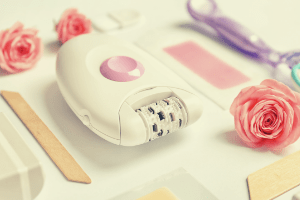At first, choosing an epilator seems like a pretty straightforward process. It just pulls hair out like tweezers, how complicated can it be? But a little further investigation and you’ll find that there are many different types of epilators on the market these days. So many, in fact, that choosing one to buy is overwhelming.
In this article, I will break down the three main types of epilators for you, plus explain all the other major variations on the market. With this information, you should have a good foundation for deciding on your next epilator purchase.
The Three Main Types of Epilators
If we divide epilators based on how they grab hairs, then there are basically three types of epilators: spring, disc, and tweezer.
Spring Type Epilators
In 1986, an Israeli company called Epilady released the first epilator. This epilator was the spring type. Spring type epilators have metal coils that rotate and move in a fashion that squeezes the coils together and then apart so they can grab hairs, pull them out, then open up to release the hairs.
Here’s a spring type Epilady epilator:
The springs on these are easily worn out and need to be replaced often. They also have a higher chance of pinching the skin and typically take more passes to pull out all hairs.
Spring epilators have mostly fallen out of popularity as newer designs have been created, although there are some manual spring type epilators still available to buy, like this one:
Rotating Disc Type Epilators
The spring type epilator was a commercial success, but the springs’ low durability made them less than ideal. In response to this, Remington used the epilator concept from Epilady, but changed up the design slightly, using an element made up of rubber discs instead of springs.
These discs were stronger and lasted longer. The discs work in much the same way as springs, though, rotating and coming together to grab hairs and pull them out and then moving apart to release the hairs. But compared to the metal coils, these discs were stronger, lasted longer, and were less painful to use.
This Lady Remington Smooth & Silky epilator commercial from 1989 shows how this type of epilator worked:
Soon after, this design began using rotating metal plates, as seen in this Braun Silk-épil model from 1990:
Tweezer Type Epilators
After more years of refining the design of epilators, most companies are now selling tweezer type epilators. As the name suggests, they work like tweezers. These epilators have a head with multiple metal plates. The plates rotate continuously to move together like tweezers, pull out hairs, then release.
This video demonstrates how the tweezer type epilator works:
Other Types of Epilators
Spring, disc, and tweezer are the three main types of epilator design. However, there are many other ways to categorize epilators. Let’s explore some of the other types of epilators.
Corded vs Cordless Epilators
You can find corded, cordless and dual epilators on the market.
Corded epilators have an attached cord that must be plugged into the wall when using the epilator. In the past, almost all epilators were the corded type.
Then there are cordless types that run on batteries. These have less power but are typically smaller and more convenient for traveling.
Today, most epilators are a combo type similar to cell phones: they have a rechargeable battery and a removable charging cord. You plug the epilator in to charge it and then you can remove it from the cord to use the epilator with more ease. However, if you don’t have time to fully charge it before you need to use it, you can leave it plugged in and charging while you use it.
Wet and Dry Epilators
Corded epilators are always dry epilators. That means they can’t be used in water. For many epilator users, this isn’t a big deal.
However, water makes epilator pain less intense, so many epilators are now designed to be waterproof. These “wet and dry” epilator models are the corded/cordless types so that you can charge the epilators, then remove the cord to use them in the shower or bath.
Manual Epilators vs Electric Epilators
All mechanical epilators are electric epilators. They won’t work without a power source. Most epilators fall into this category.
But there are also manual epilators. These are super simple versions of the spring type epilators.
They are basically just one long spring with handles on each end. You hold the handles and roll the spring against your skin. As you are rolling, the coils grab hairs and pull them out.
These are really inexpensive and use no electricity, but they lack durability and just don’t work very well. Most people use them for peach fuzz or small areas of facial hair, like in this video:
Body Epilators vs Leg Epilators
You may notice that some epilator descriptions seem to make a distinction between epilators for legs and epilators for the body. This seems odd because the legs are usually considered part of the body, right?
The main difference is that epilators designed for the legs usually can cover a larger area quickly and put less attention into reducing irritation and pain. Legs generally can take more pain and speed and don’t need to be handled as gently.
Epilators designated for the body are typically designed for sensitive areas like underarms and the bikini area. They have a smaller head to epilate a small area at a time and may have lower speeds.
Most epilators you will find are for both legs and body. They usually do this by having different caps to put on the heads. They also may have different speeds so you can use lower speeds on more sensitive areas.
Facial Epilators
There are very few epilators on the market specifically designed for facial hair only. These models are smaller and lighter, with narrow heads so you can gracefully navigate around the face to remove upper lip, chin, forehead, and eyebrow hair. They use less power, so are often a little slower and quieter, which provides a more gentle experience for the more delicate areas of your face.
Besides epilators for face only, most of the top epilator models come with attachments so you can use them for the face. This can work fine for a lot of people, but larger epilators and harder to maneuver around the face.
Women’s Epilators vs Men’s Epilators
If you couldn’t tell from the feminine designs and the overabundance of purple, pink, and light blue, almost every model of epilator is designed for and marketed to women.
But there are a few epilators out there marketed specifically to men. There are three features that usually distinguish these from the other epilators on the market:
Men’s epilators are typically black or another “manly” color. Gotta love gender stereotypes, right?
They are also usually designed to remove coarser hair as the body hair on most men is a bit thicker and coarser than women’s body hair.
And men’s epilators usually come with a trimmer attachment.
However, almost all the best epilators for women these days come with trimmer attachments and can remove coarse hairs, so men don’t necessarily need an epilator “for men,” unless they just can’t handle a “girly” color or design.
Types of Epilator Brands
There are dozens of companies that make epilators. However, the most popular and reputable brands currently selling in the United States include Braun, Panasonic, Emoji, Philips, Remington, and of course, Epilady.
Most of these companies specialize in personal care products like epilators and trimmers.
Final Takeways
Epilators have a come a long way since they first hit the market in 1986. Whether you need one to just keep your brows groomed or you want to remove hair all over your body, there is probably a type of epilator that will meet your needs.
Related Questions
What’s the best beginner epilator?
In my opinion, the overall best epilator is the Braun Silk-épil 9. However, if you are a beginner, I recommend the Emjoi Epi Slim (click to check it out on Amazon).
This epilator is small and works best for the face, underarms, or bikini area. But it has a low price that gives you the chance to test out epilation without spending tons.
After you’ve been epilating for a while and know it’s something you will be doing long-term, you can simply upgrade to a better epilator and use this as a back up or travel epilator.
Have more questions about epilation? Check out the Epilator FAQ and Beginner’s Guide!
Want to remember this? Pin this to your favorite Pinterest board so you can find it later!

